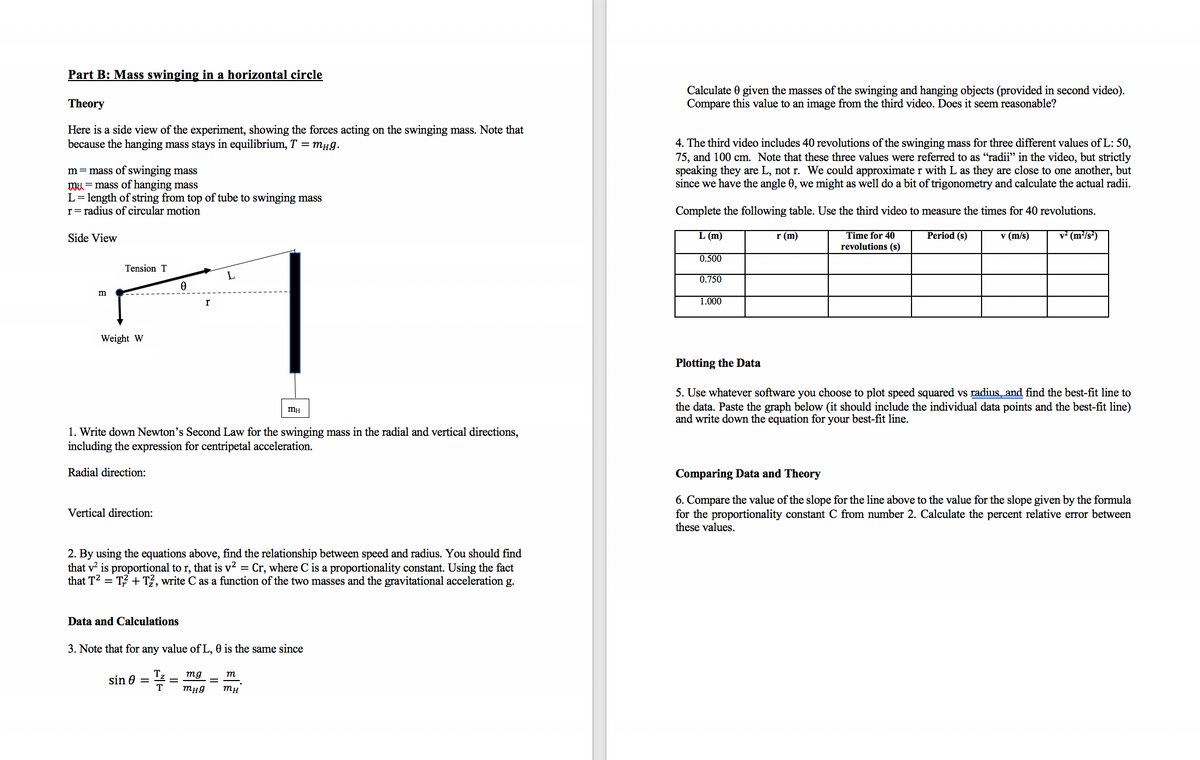Part B: Mass swinging in a horizontal circle Theory Here is a side view of the experiment, showing the forces acting on the swinging mass. Note that because the hanging mass stays in equilibrium, T = mµg. m=mass of swinging mass mu = mass of hanging mass L= length of string from top of tube to swinging mass r= radius of circular motion Side View Tension T Weight W m 1. Write down Newton's Second Law for the swinging mass in the radial and vertical directions, including the expression for centripetal acceleration.
Part B: Mass swinging in a horizontal circle Theory Here is a side view of the experiment, showing the forces acting on the swinging mass. Note that because the hanging mass stays in equilibrium, T = mµg. m=mass of swinging mass mu = mass of hanging mass L= length of string from top of tube to swinging mass r= radius of circular motion Side View Tension T Weight W m 1. Write down Newton's Second Law for the swinging mass in the radial and vertical directions, including the expression for centripetal acceleration.
Related questions
Question

Transcribed Image Text:Part B: Mass swinging in a horizontal circle
Calculate 0 given the masses of the swinging and hanging objects (provided in second video).
Compare this value to an image from the third video. Does it seem reasonable?
Theory
Here is a side view of the experiment, showing the forces acting on the swinging mass. Note that
because the hanging mass stays in equilibrium, T = mµg.
4. The third video includes 40 revolutions of the swinging mass for three different values of L: 50,
75, and 100 cm. Note that these three values were referred to as "radii" in the video, but strictly
speaking they are L, not r. We could approximater with L as they are close to one another, but
since we have the angle 0, we might as well do a bit of trigonometry and calculate the actual radii.
m=mass of swinging mass
mu = mass of hanging mass
L= length of string from top of tube to swinging mass
r=radius of circular motion
Complete the following table. Use the third video to measure the times for 40 revolutions.
Time for 40
revolutions (s)
v² (m²/s*)
Side View
L (m)
r (m)
Period (s)
v (m/s)
0.500
Tension T
0.750
1.000
Weight W
Plotting the Data
5. Use whatever software you choose to plot speed squared vs radius, and find the best-fit line to
the data. Paste the graph below (it should include the individual data points and the best-fit line)
and write down the equation for your best-fit line.
1. Write down Newton's Second Law for the swinging mass in the radial and vertical directions,
including the expression for centripetal acceleration.
Radial direction:
Comparing Data and Theory
6. Compare the value of the slope for the line above to the value for the slope given by the formula
for the proportionality constant C from number 2. Calculate the percent relative error between
these values.
Vertical direction:
2. By using the equations above, find the relationship between speed and radius. You should find
that v? is proportional to r, that is v2 = Cr, where C is a proportionality constant. Using the fact
that T2 = T? + T2, write C as a function of the two masses and the gravitational acceleration g.
Data and Calculations
3. Note that for any value of L, 0 is the same since
Tz
sin 0 =
T
mg
m
Expert Solution
This question has been solved!
Explore an expertly crafted, step-by-step solution for a thorough understanding of key concepts.
This is a popular solution!
Trending now
This is a popular solution!
Step by step
Solved in 2 steps with 1 images
